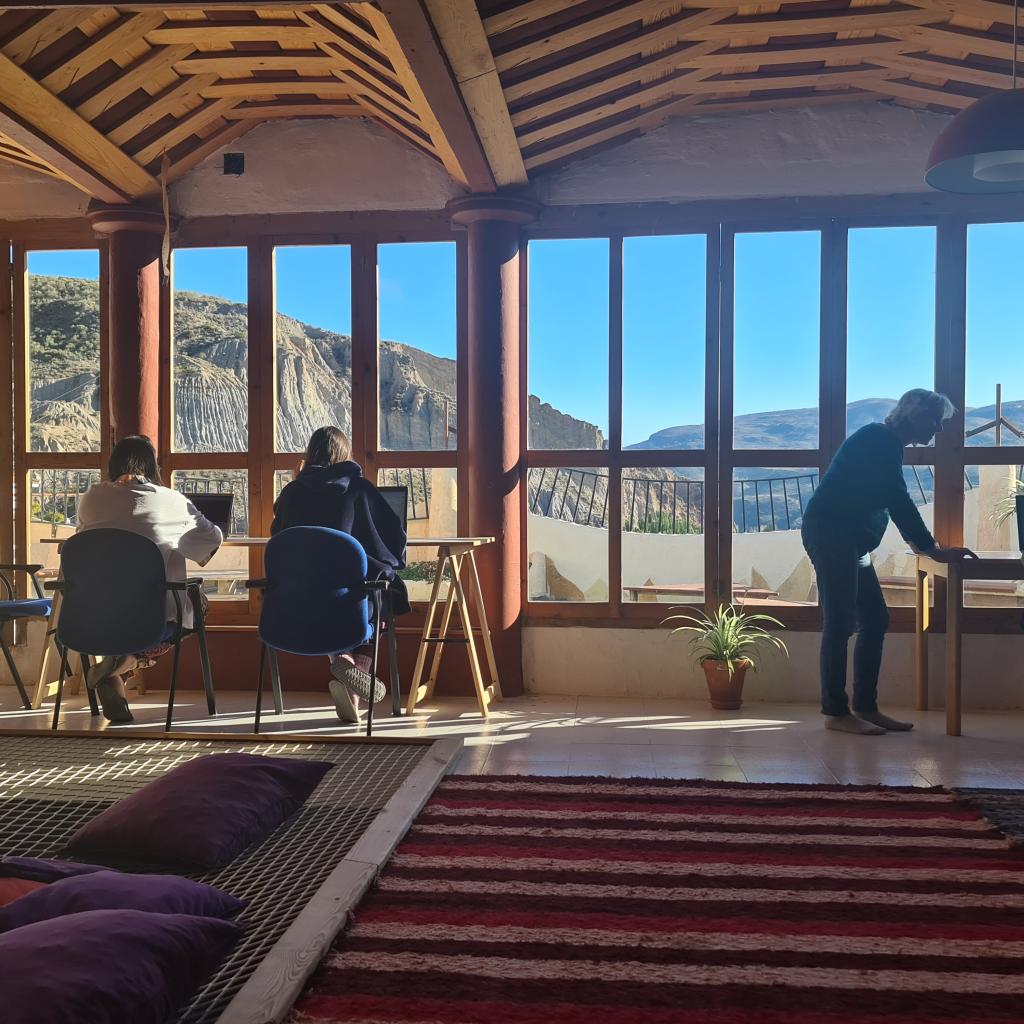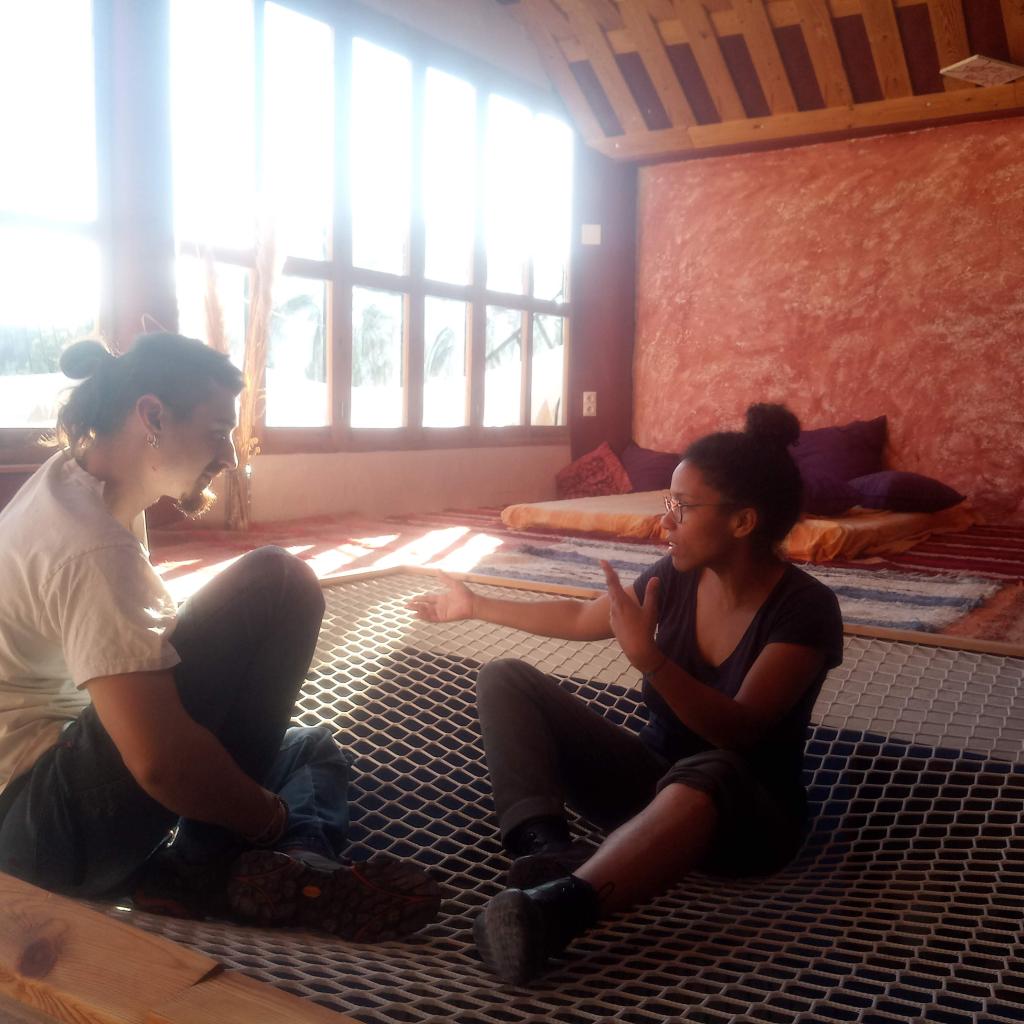In this article, we explore how the new wave of coliving and coworking spaces are reshaping communal life. From the history of intentional community to the rise of coliving as a flexible alternative, we look at how nomads, digital nomads, and entrepreneurs are finding belonging, inspiration, and professional support
- What is an Intentional Community?
- The Challenges of Joining an Intentional Community
- Coliving – A Gamechanger in Flexible Communal Living
- It All Started with the Coworking Movement
- Coworking and Coliving – A Powerful Symbiosis
- Coliving and a new tribal Nomadism
- Coliving and Digital Nomads
- Coliving as Second Life
- Coliving as a Way to Find Out: “Is Community for Me?”
1. What is an Intentional Community?
Living together with shared values is as old as humanity. Villages, tribes, and monasteries were early forms of intentional community where people chose connection over isolation. Today the term describes groups who consciously organize their lives around a common vision, sharing housing, land, or facilities, and supporting each other through culture, collaboration, and daily life.
These communities are often misunderstood. Some imagine a hippie commune or a cult in the forest, but the reality is more diverse. Around the world you can find urban cohousing projects, rural ecovillages, eco-spiritual retreats, cooperative housing blocks, and even networks of modern co-living homes. Some are intimate, others are thriving villages with hundreds of residents.
What unites them is a choice to step outside consumerism and competition, and instead practice shared responsibility. By pooling resources, members live more lightly on the planet: gardens instead of supermarkets, renewable energy instead of fossil fuels, shared workshops instead of private garages. Many intentional communities also serve as laboratories for sustainability and new cultural models.
The growth of intentional communities also reflects a deep human need. Loneliness is one of the greatest health risks of modern life. Communities offer companionship, trust, and belonging that many miss in fragmented cities. Joining such a group is not about escaping the world, but about creating alternatives that can inspire it, proving that another way of living together is already alive across the globe.
2. The Challenges of Joining an Intentional Community
The vision of intentional community is inspiring, yet the path to becoming part of one is rarely simple. Communities are not ready-made spaces; they are built slowly through money, labor, and human care. For newcomers, this often means either helping to create a project from the ground up or finding an existing group that feels like a fit. Both paths demand patience and commitment.
Entry is usually selective. Visits, trial stays, or formal applications ensure compatibility and trust. Once inside, members are expected to be reliable, since many communities struggle with social and structural stability. Leaving can be complex: investments are often non-refundable, and departures may stir conflict. “Community hopping” is discouraged. Stability and dedication are key.
3. Coliving – A Gamechanger in Flexible Communal Living
Coliving (or co-living) brings a fresh chapter to communal life, blending shared values with modern flexibility. At its core, coliving means renting a private room in a shared environment with communal amenities. It fosters connection and belonging, without the permanence of traditional intentional communities.
Coliving is adaptable: stays are flexible, spaces furnished, utilities included, and everything ready to move into. Beyond logistics, many coliving projects provide a ready-made cultural framework: group activities, conflict resolution practices, and personal growth opportunities. Some even aim for positive impact in the world, combining individual comfort with collective purpose.
The gamechanger is this mix: the intimacy of an intentional community with the freedom of modern life—accessible to anyone, without long-term obligations.
4. It All Started with the Coworking Movement
Before coliving, there was coworking (co-working). In the early 2000s, freelancers and startups sought alternatives to working alone. Shared offices offered not just desks and Wi-Fi, but collaboration, exchange, and community. The first official coworking space opened in San Francisco in 2005, and the model spread across Europe, the US, and Spain.
The essence of coworking is flexible access to infrastructure and a culture of openness. Soon the same logic was applied to housing: if people could share workplaces, why not homes? From this inspiration, coliving was born.
5. Coworking and Coliving – A Powerful Symbiosis
When coworking and coliving merge, they form a powerful symbiosis. Coworking provides focus and creativity. Coliving adds belonging and the comfort of shared life. Together they create a lifestyle where work and life are not in competition, but in balance.
Ideas are exchanged at the desk and deepened over dinner. Friendships spark projects, collaborations emerge naturally, and professional growth is supported by the creativity of the group. At its best, this blend nurtures a network of trust and inspiration—an ecosystem where people thrive not only through their own work, but through shared support.
6. Coliving and Nomadism
For nomads, constant travel often meant new beginnings and endless goodbyes. Coliving has changed this. A growing network of coliving houses lets nomads enjoy freedom of movement while staying embedded in a community.
Instead of starting from zero in each city, nomads step into spaces already alive with values, rhythms, and connection. Many meet the same people again in different countries, creating continuity across borders. Over time, this has grown into a worldwide tribe of nomads, carrying friendships, collaborations, and shared memories across continents.
Coliving allows nomads to live in motion while carrying a sense of home within community, a global journey of belonging.
7. Coliving and Digital Nomads
When coworking is part of coliving, it goes further. Digital nomads and entrepreneurs are building a worldwide professional network embedded in community life. Coliving–coworking spaces become nodes where ideas, skills, and opportunities flow.
A project sparked in Spain can continue months later in Mexico or Bali. Friendships evolve into collaborations, professional networks expand organically, and opportunities multiply across borders. The result is a global tribe of nomads, bound by trust, inspiration, and entrepreneurial energy.
8. Coliving as Second Life
Coliving can also serve as a “second life.” A city-dweller may choose to spend two or three months each year in a coliving space, immersed in nature and community. Everything is prepared, housing, infrastructure, social rhythms, so nothing lies unused when they return home.
Some people return to the same coliving year after year, building long-term friendships until it feels like a second home. Others dive into new projects each time, exploring fresh contexts and temporary lives. Either way, coliving allows people to weave an additional chapter into life: a parallel rhythm of community and transformation alongside their primary home.
9. Coliving as a Way to Find Out: “Is Community for Me?”
Not everyone knows if they want to live in an intentional community or ecovillage long-term. Coliving offers a flexible way to explore this. By joining for a few weeks or months, you can test how it feels to share meals, decisions, and rhythms—without heavy commitments.
Coliving becomes a laboratory: you discover how much privacy you need, how you enjoy group activities, and how communal life enriches you. Even if you decide intentional community is not your path, the experience brings growth, connection, and insight. And if it resonates deeply, it can be the gateway to joining or founding an ecovillage or other form of intentional community.


